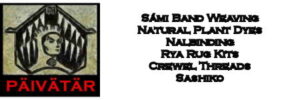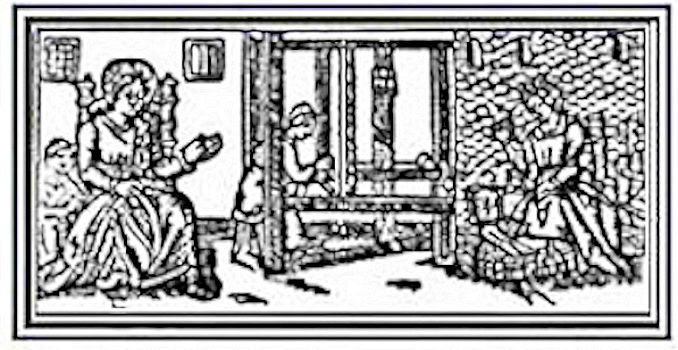A 3 metre strand of yarn tells a story of Norse explorations to Baffin Island in the 13th Century. The yarn was buried in the tundra for almost 800 years and was found in 1984, by Father Guy Mary-Rousseliere, the parish priest at Mittimatalik (Pond Inlet). The artifacts were sent to the Canadian Museum of Civilization.
About 15 years later, while working on Father Mary-Rousseliere’s collections, Patricia Sutherland, Associate Curator of the Museum, noticed that the yarn fragment was similar to ones she had seen at an archaeological excavation of a medieval Norse farm in Greenland.
The Yarn was identified as a blend of fur of the Arctic hare and goat hair. Penelope Rogers, a specialist who studied textiles from the Greenland Norse sites, confirmed that this yarn was similar to a specimen from the Norse farm Garden Under Sandet. Northern Baffin Island was occupied by Dorset Palaeo-Eskimos from 500 B.C. to 1500 A.D. who did not spin or weave, but wore clothing sewn from animal skins. Because yarn was not generally used by the Dorset people, it is thought that it would have been more of a curiosity item, and suggests of a visit to the region by a Norse ship. As a result of this discovery, the Canadian Museum of Civilization is now conducting the Helluland Archaeology Project that could reveal additional information about the contacts between the Norse and the Aboriginal peoples of the eastern Arctic. Patricia Sutherland has found additional evidence of spun yarn and worked wood at other Baffin Island sites that are characteristic of technologies of medieval Europe. Radiocarbon dating of the spun yarn samples indicate that a European presence may have begun earlier than previously thought.
Discovery at Canadian Museum of Civilization
A 3 metre strand of yarn attracts the attention of researchers.
Helluland Archaeology Research Project
The Canadian Museum of Civilization studies the contact between the Norse and the Aboriginal peoples of the eastern Arctic.
Nunguvik Site
Father Mary-Rousseliere describes the excavations at the Nunguvik site.
The Last Viking
An extensive essay that discusses the importance of spinning and weaving as an indicator of a Norse presence in the Canadian Arctic as well as the Pacific Northwest.
Canadian Museum of Civilization
Viking Age Textiles
Blue Skirts and Golden Belts
Viking age clothing of Finland.
Textile Books: Viking Textiles
Woven into the Earth: Textile finds in Norse Greenland (None)
When Poul Norlund recovered dozens of garments from a graveyard in the Norse settlement of Herjolfsnaes, Greenland. Preserved intact for centuries by the permafrost, these mediaeval garments display remarkable similarities to western European costumes of the time.
Medieval Garments Reconstructed: Norse Clothing Patterns
Chapters on technique – production of the thread, dyeing, weaving techniques, cutting and sewing – by Anna Norgard. Also included are measurements and drawings of garments, hoods, and stockings, with sewing instructions, by Lilli Fransen. A practical guide to making your own Norse garment.
Medieval Tailor’s Assistant: Making Common Garments 1200-1500
Viking Clothing
This new book is the first to tackle the question of what the Vikings wore, drawing on evidence from art and archaeology, literature and linguistics to arrive at a fresh understanding of the nature of Viking clothing, covering rich and poor, men and women across Scandinavia. It includes an overview of Viking textiles and dyeing, and an exploration of cloth production and clothing in the context of Viking society as a whole.
[sc name=”medianet300x250″]
[ebayfeedsforwordpress feed=” http://rest.ebay.com/epn/v1/find/item.rss?keyword=spinning+wheel&categoryId1=14339&sortOrder=BestMatch&programid=1&campaignid=5336495175&toolid=10039&minPrice=100.0&listingType1=All&descriptionSearch=true&feedType=rss&lgeo=1″ items=”3″]
[sc name=”Amazon-Bottom”]
 LONGTHREAD MEDIA VIDEO
LONGTHREAD MEDIA VIDEO
 LONGTHREAD MEDIA SUBSCRIPTIONS
HANDWOVEN MAGAZINE
PIECEWORK MAGAZINE
SPINOFF MAGAZINE
LEARN LONGTHREAD MEDIA
PAIVATAR HANDMADE
LONGTHREAD MEDIA SUBSCRIPTIONS
HANDWOVEN MAGAZINE
PIECEWORK MAGAZINE
SPINOFF MAGAZINE
LEARN LONGTHREAD MEDIA
PAIVATAR HANDMADE
 Paivatar on YouTube
Visit my YouTube channel for how-to craft videos.
Paivatar on YouTube
Visit my YouTube channel for how-to craft videos.
Or Please visit my Channel on Rumble for more how-to videos.
https://rumble.com/Paivatar
LIVE STREAMS - Paivatar Studio
KICK
TWITCH MAKERS&CRAFTING
YOUTUBE
Categories: Heritage Crafts


